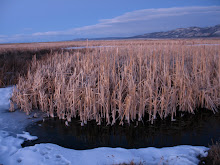 As I hold the barbed wire up for Chris and he ducks under, I say, "This is the threshold where the more wild Sunshine Valley starts." But maybe it is less a questions of "wild" and more a question of the presence or absence of current human involvement.
As I hold the barbed wire up for Chris and he ducks under, I say, "This is the threshold where the more wild Sunshine Valley starts." But maybe it is less a questions of "wild" and more a question of the presence or absence of current human involvement.There are certainly plenty of remnants if human presence on the land beyond this barbed wire. The fence itself indicates the introduction and control of livestock movement on the land. There is a decomposing pair of wooden buildings and also what I've heard referred to as an old potato storage building. And Chris reminds me that the wetlands themselves are a man-made phenomenon.
Today as we walk along the road, we notice recent vehicle tracks. Someone has been here recently in a vehicle, someone with a key to unlock the padlock on the barbed wire gate across the road. The tracks are muddy, squishy, relatively recent. Halfway down the road, I stop to take a photo of the tracks. Chris gets very quiet and "shhhh!" asks me to be still. He and our dog, Kibbe, cock their heads and listen carefully. At first I don't hear anything. I move into a better listening postition, lowering my hood and hat to free my ears. And then I hear it - a faint, chaotic collage of high pitched sounds. Chris cups his hands around his ears, creating ear-extending sound catchers. He says it sounds like a hodgepodge of muddled radio frequencies.
 I do the same. It works! We hear better and I begin to make out birdsong amongst the chaos. I am beginning to think that we may be witnessing one of the first spring evening red winged blackbird choruses.
I do the same. It works! We hear better and I begin to make out birdsong amongst the chaos. I am beginning to think that we may be witnessing one of the first spring evening red winged blackbird choruses.We quicken our pace, excited to arrive and test our hypothesis. We stop at the old cow feeding station . We stop again, listening. This time it's clear - definitely red winged blackbirds and lots of them. For me, this is a definite indication of the beginning of spring and the return of the light. Just weeks ago the wetlands were silent, even at dusk, its song little more than the shifting of ice. This is a transition time.
On the threshold of the wetlands we stop to listen and watch. There is a great deal of movement and excitement among the birds. As we approach, they are startled and fly in a flock away from their favorite spot at the mouth of the culvert, where the water flows freely from one side of the wetlands to the other.
 Photo by Chris Cote
Photo by Chris CoteI am thrilled by their flight as they swoop over us and bank south to their new landing spot and settle into song again. Their vocal range and beautiful but discordant woven song is both intriguing and haunting.
As they settle back into the reeds we sit and listen absorbing it all, until the cold gets the better of us and we turn homeward.
As they settle back into the reeds we sit and listen absorbing it all, until the cold gets the better of us and we turn homeward.




















